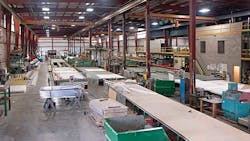Great Dane starts body production at a flagship trailer plant
FOR decades, Great Dane Trailer’s sprawling trailer plant in Brazil, Indiana, has been building trailers by the thousands.
But recently, in one of the buildings on Great Dane’s Brazil campus, the trailer manufacturer began manufacturing refrigerated van bodies for its sister company—Johnson Truck Bodies of Rice Lake, Wisconsin.
The move appears to be a win-win for the two companies, both of whom are owned by CC Industries of Chicago. It gives the plant an additional product to manufacture—but one that uses existing materials, processes, and technology. More importantly, though, the move provides Johnson with a conventional sheet-and-post insulated body that supplements the fiberglass design on which Johnson has built its reputation.
Production of the company’s new Alpine refrigerated body began in April. By the end of this summer, the plant had completed several large orders for leasing companies and refrigerated fleets.
When one company acquires another company, the announcement often touts the potential synergies that the acquisition is going to produce. Those synergies can be elusive, but the joint Great Dane-Johnson project has been a case of readily shared technology. Here are some examples:
• The body mounting system comes from Johnson.
• The expertise of mounting liftgates also comes from Johnson. While Great Dane dealers and factory branches routinely install liftgates, it’s new at the factory level.
• The van body design and manufacturing expertise comes from Great Dane.
“It has been a great exchange of ideas,” says Cory Lookebill, plant manager. “Johnson now can offer a sheet-and-post body that can be easily repaired using the same techniques that are used to repair trailers. We employ a lot of the same manufacturing processes that we use to build Great Dane refrigerated trailers. We can share the same production lines and even mix trailers and truck bodies on the same line.
“But it goes the other way, too. We have learned from Johnson, especially when it comes to truck body mounting and liftgate installation.”
The Johnson van body mounting system makes it easy to mount the body on another chassis, Lookebill says. Great Dane offers a mounting kit that allows the body to be installed on site. The company also offers to mount the bodies at the plant or at an authorized dealership or factory branch.
Johnson’s mounting system does not employ U-bolts. Instead, brackets are welded to the long sills of the body. The down-facing legs of the angle brackets are then bolted to the chassis frame using 5/8-inch Grade 8 bolts.
Great Dane employees also have received tips from their counterparts at Johnson Truck Bodies on liftgate installation.
“Liftgate installation is fairly new here in Brazil,” Lookebill says. “We went to the Rice Lake plant to learn from them along with experts from Maxon and Waltco.”
Great Dane took that training back home and applied it. Three Great Dane plants now install liftgates, including Brazil, Indiana; Kewanee, Illinois; and the company’s new refrigerated trailer plant in Statesboro, Georgia.
Stark contrast
The contrast is stark between what Johnson Truck Bodies traditionally has offered and the Alpine bodies that are now being built at the Great Dane plant in Brazil.
Johnson’s established Blizzard vans are true composite bodies that feature fiberglass skins and a urethane foam core. These panels are used to form the sidewalls as well as the roof. An internal frame made of steel hat sections provides strength, but the foam core separates the steel from external heat. The company’s Guardian series, aimed more at home delivery of ice cream and other frozen products, uses the same basic construction system as Blizzard bodies.
Meanwhile, back in Brazil, Johnson’s Alpine bodies are built using standard 0.040-inch aluminum skin and 1 1/8-inch J-section side posts mounted on 16-inch centers. Seamless 0.090-inch fiberglass liners are standard. However, the company also offers the same PunctureGuard liners that are available on Great Dane trailers. ThermoGuard liners, also available on Great Dane trailers, are options, too. They are designed to reduce out-gassing of the urethane insulation and resist moisture absorption into the insulation.
Building the bodies
Great Dane carved out an approximate 60-ft x 320-ft area in its plant for truck body production. However, the company also draws from other areas of its plant to fabricate parts and produce subassemblies that Alpine truck bodies require.
“One big difference is in the dimensions of the product,” Lookebill says. “The shortest van body we have built so far is 16-foot. The longest we have built so far is 26-feet long—still less than half of a standard 53-foot van trailer.”
The truck bodies, Lookebill says, did require some new extrusions—particularly the lower rail. But generally the products and the process are similar.
“We have learned a lot when we transitioned from a mandrel process for insulating our vans,” Lookebill says. “It’s so easy to get voids in the insulation when you try to foam vertical walls.”
Lookebill say that foaming panels, rather than the entire van, offers a variety of advantages, including:
• Flatter panels are easier to control.
• Flat lining with no voids
• Thermal breaks are sealed properly.
The similarities between the Alpine van bodies and Great Dane reefer trailers have made it easy for the company to transition into production of this new product.
“You can almost consider them to be Great Dane reefer trailers that are mounted on a chassis,” Lookebill says.
About the Author
Bruce Sauer
Editor
Bruce Sauer has been writing about the truck trailer, truck body and truck equipment industries since joining Trailer/Body Builders as an associate editor in 1974. During his career at Trailer/Body Builders, he has served as the magazine's managing editor and executive editor before being named editor of the magazine in 1999. He holds a Bachelor of Journalism degree from the University of Texas at Austin.
